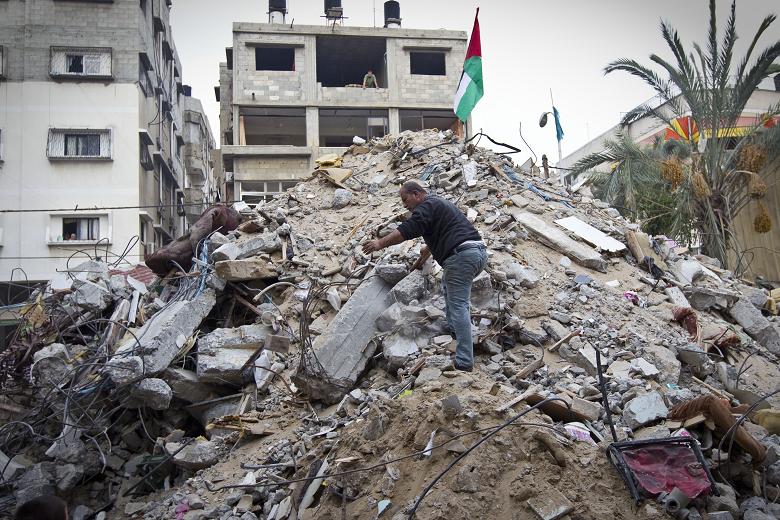Targeting Gaza Homes—again

The number of homes damaged in the attack on the Gaza Strip in November 2012 reached 10,000, including 120 homes destroyed completely. The total number of Palestinian family homes destroyed or seriously damaged reached 450. The attack on residences displaced 12,000 people during the hostilities, taking shelter in 14 UNRWA schools. Some 3,000 remain displaced and homeless because of damage to their homes under the Israeli bombardment. In addition, approximately 15,000 people were estimated still to be lodging with host families in December.
The assessment issued by the Office for the Coordination of Humanitarian Affairs in the Occupied Palestinian Territories (OCHA), on 18 December 2012, reported that Israeli forces targeted 1,500 sites in the Gaza Strip, compared to the assault in 2008–09, in which Israel targeted 500 sites. In addition to the physical destruction, the wide-spread nature of the attacks and residue from the ordnance also constitute a danger to the general population that may also hinder access to vital agricultural land.
On 14 November afternoon, at approximately 15:45, the Israeli Air Force (IAF) launched an airstrike that targeted and killed Ahmad al-Jabari, the acting chief of Hamas’ armed wing, in his car. That strike marked the start of the military offensive code-named “Operation Defensive Pillar” and followed several weeks of intermittent escalations in violence, during which Palestinian armed groups indiscriminately fired rockets into southern Israel, and the IAF attacked various targets inside Gaza.
The last full-scale Israeli operation in Gaza, “Cast Lead,” between 27 December 2008 and 18 January 2009, had a devastating impact on the civilian population, resulting in thousands of deaths and injuries, and massive destruction of homes, infrastructure and livelihoods. Since then, limited escalations in violence have taken place every few weeks, affecting civilians in Gaza and threatening residents in southern Israel.
The extreme vulnerability of the civilian population in the Gaza Strip has been exacerbated by the intensification of the land, air and sea blockade imposed by Israel following the Hamas takeover of Gaza in June 2007. Despite some easing measures implemented since mid-2010, the blockade is still ongoing.
The Housing and Land Rights Network has followed reports on the grave Israeli violations in the Gaza Strip in the process of “Operation Pillar of Defense” (Hebrew: עַמּוּד עָנָן, ʿAmúd ʿAnán, literally: Pillar of Cloud), which lasted for a week from 14 until 21 November 2012. On Friday, 16 November, the Israeli bombardment destroyed the al-Salāh family home, injuring all 31 family members to various degrees, ranging between moderate and serious. On Sunday, 18 November, the IAF destroyed the family home of the 16-member al-Dillū family, killing 11 and wounding 10, including the martyrdom of four children and four women. On Monday, the 19th, Israeli shelling destroyed the `Azzām, Abū Zūr and Hijāzi family homes in different parts of the strip, killing four civilians, including a child, a young man and two women. These attacks also injured more than 35 citizens, mostly children, seven of whom seriously.
This pattern reaffirms that Israel continues to pursue a military policy of attacking homes as a means of punishing and terrorizing civilians in its conduct of war. As reported in the HIC-HLRN submission to the UN Fact-finding Commission on the Conflict in Gaza 2008–09 (Goldstone Commission), and cited in its report (pp. 210, 214, 253, 258, 265), this strategy forms part of an unbroken continuum of Israeli military doctrine since 10 March 1948. The continuation of Israel’s practice of house demolitions throughout the occupied State of Palestine has continued through 2012, destroying 543 homes and displacing 817 Palestinians, in addition to the Gaza attacks.
Whether in historic Palestine since 1948, since 1967 in the West Bank and Gaza Strip, or subsequently in Lebanon, Israel’s military doctrine of mass demolition of houses and destruction of public and private property are strictly prohibited by the Fourth Geneva Convention (§53) and its Protocols (§ 51.5–7) and the Rome Statute of the International Criminal Court (§ 7.1(k); 8(iv),(xii)). The Fourth Geneva Convention also explicitly prohibits collective punishment in any form (§33).
The follow-up to the Goldstone report, in particular, the investigations of the subsequent UN Committee of Independent Experts, failed to address the need to investigate these alleged crimes at the command and policy level. And at the close of 2012, this consistent Israeli practice was repeated. The repetition was predicted with the failure of all parties—not least the Security Council, ICC prosecutor and the Geneva Conventions’ depositary government—to ensure respect for international humanitarian law, establish accountability and, ultimately, deter this long-criminalized military practice.
|